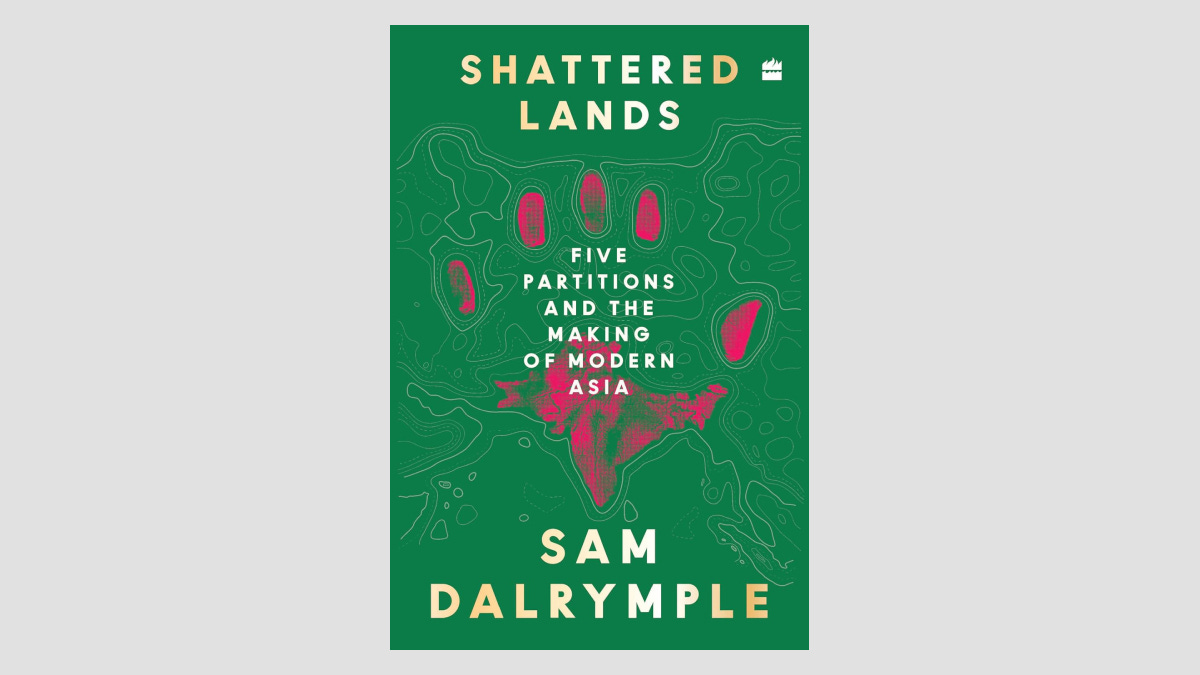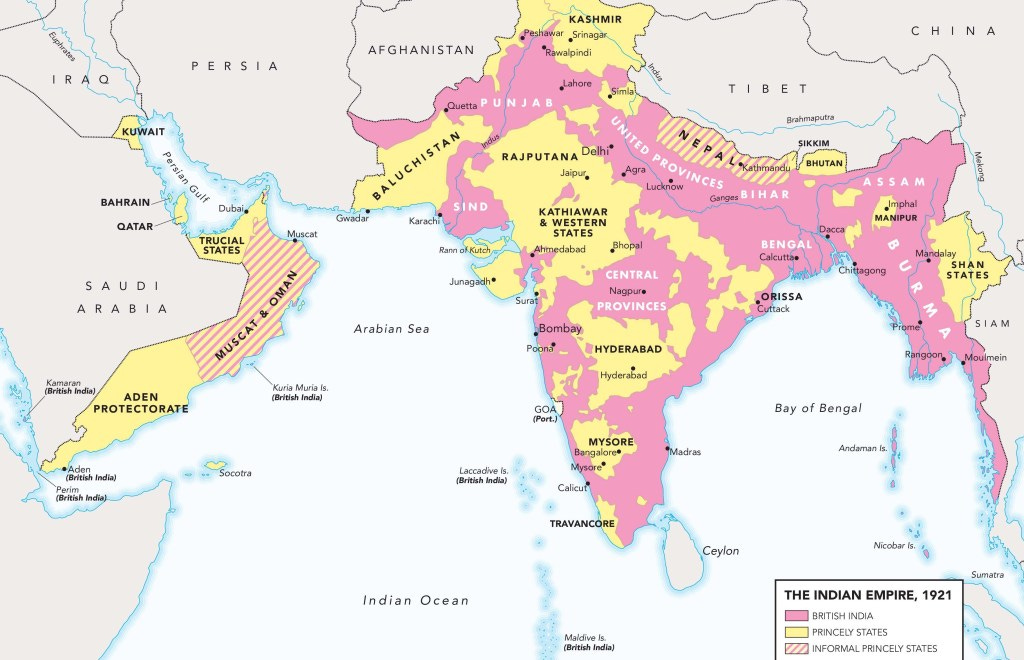BOOK REVIEW: Shattered Lands (Five Partitions and the Making of Modern Asia)
By Sam Dalrymple. William Collins, London, £25 hardback, India: Harper Collins India, New Delhi, hard cover, 528 pp, Rs799, US33.99
By: John Elliott
For most people, even those well-versed in colonial history, the word “partition” mainly conjures up images of the hundreds of thousands of Muslims and Hindus who were killed in 1947, fleeing between northern India and Pakistan at the time of independence from Britain. Little is even remembered about similar crossings in the east between what is now West Bengal and Bangladesh.
Sam Dalrymple explores these events in detail in his book Shattered Lands and then goes on to break important new ground by taking the story much further to include Imperial India’s little-known total of five partitions. Delhi’s writ stretched from the Indian Subcontinent across the Arabian Sea to what is now Yemen, Oman, the UAE, Qatar, Bahrain, and Kuwait. That was in addition to India’s neighbors Burma (Myanmar), and the somewhat reluctant protectorates of Nepal, Bhutan, and Sikkim.
The Indian Raj “housed a quarter of the world’s population and was governed by the Indian rupee,” Dalrymple writes. He has left out Afghanistan, which never became part of the empire, even though Britain fought several wars there and controlled its foreign policy for 40 years.
The Arab states bordering the Ottoman Empire, we learn, were usually left off Imperial maps to avoid annoying Constantinople, while Nepal and Oman never officially recognized their protectorate status. Yet they were all legally part of “India” – run by the Indian Political Service and subservient to the Viceroy of India. Defended by the Indian Army, they paid Indian taxes with Indian rupees.
That establishes the contours that Dalrymple has devised for this wide-ranging book, which shows how haphazardly many historically significant decisions were taken. Some were hurried with almost random implementation, creating problems that remain today – notably trouble-torn Kashmir, which is divided and claimed by both India and Pakistan. Some claims for partition were rejected – Nagaland has never fully accepted being a state in northeast India and could have become part of Burma (Myanmar).
The partitions began in 1937 when Burma was separated from India as a crown colony to meet anti-Hindu-India nationalist demands and enable London to establish direct links separate from Delhi. Also, that year, the separation of Aden began the Arabian Peninsula partitions that continued until the Persian Gulf states joined in 1947.
India’s political leaders did not oppose losing the (Muslim) Gulf states, and Dalrymple describes this as “India’s greatest lost opportunity” because of the oil wealth that was discovered later. But for these partitions, he says, the countries “might have become part of India or Pakistan after independence”. That, however, is surely a most improbable “what if….”, not least because of the unreality of expecting those Muslim nations to accept life run from Hindu India.
The bloody creation of Pakistan in 1947 came next, which Dalrymple presents as an idea that flowed from the partitions of Burma and Aden. After years of discussions, Jawaharlal Nehru, who was about to become independent India’s first prime minister, admitted “we are tired men” and said the plan for partition “offered a way out and we took it.” Dalrymple, however, doesn’t adequately blame Nehru for killing off an earlier “way out.” In a July 1946 speech, he had refused to honor what was known as the widely accepted “Cabinet Mission” plan for a federal set-up, which would have avoided the violent partition and all that followed.
Next came the fourth partition when the new Indian government headed by Nehru and his tough Home Minister, Sardar Patel, virtually instructed India’s 562 princely states to cede to Delhi. Britain had only directly ruled 60 percent of the Indian land mass. The rest belonged to these states that were independent, up to a point. They were subordinate to the British crown in foreign policy, defense, and communications, and their maharajas and lesser princely rulers were subject to advice from an often-interfering British Residents (political agents).
Nehru and Patel never recognized them as having any right to independence, but they were less committed about the kingdoms of Nepal, Bhutan, and Sikkim, which had varying treaties with the British raj. Nehru was sympathetic to their Himalayan identity, and they were left off the list. Nepal became a sovereign nation, and Bhutan and Sikkim kept special independent status. (Indira Gandhi annexed Sikkim in the mid-1970s, and China is now trying to undermine Bhutan’s friendship treaty with India.)
As the empire gradually “shattered,” some colonies became republics, cutting all links with Britain, while others settled for dominion status and became part of the Commonwealth, which later also admitted republican India and others. Dalrymple sadly does not deal with this aspect of international affairs. That may be because he focuses on the gradual decline of the empire, rather than tracking later institutions, though the idea of the Commonwealth goes back to the 1880s.
Within the Indian subcontinent, the colonies of Pakistan (with Bangladesh hived off in 1971 as Dalrymple’s fifth partition) and Ceylon (Sri Lanka) did join the Commonwealth, but Nepal and Bhutan did not because they prized their independence. Neither did Burma. The Gulf states were technically eligible but chose the regional Gulf Co-operation Council that was set up in 1981. That was in line with earlier opt-outs by Palestine and others in the region, though Palestine and Yemen did apply for membership in 1997 without any decision. (Palestine’s case and the role of the Commonwealth is now being informally discussed (see this link) at a time of growing international support for its statehood).
Dalrymple vividly covers the collapse of British rule in the Gulf once these countries had lost their role in the Indian raj, and an energized Arab nationalism clashed with fading British imperialism. After almost coming to hostilities, there was the Sultan of Oman’s US$3 million sale of the important Arabian Sea port city of Gwadar to Pakistan in 1958. The Sultan held the city that lay on the Pakistani coast under a 1783 treaty. (Gwadar, in Balochistan province, is now a key nautical link in the Pakistan leg of China’s Belt and Road Initiative, and a center for Baloch nationalist opposition to rule from Islamabad).
Significantly, Dalrymple shows how the current Indian government’s Hindutva focus has roots in these years when the British tacitly agreed that “India belonged primarily to the Hindus” and hived off the largely non-Hindu parts. Hindu nationalism “was a key driving force in those earlier partitions” of Burma and Aden, as well as the later divide of India and Pakistan.
As he weaves his way through this history, Dalrymple introduces gems that would not be picked up by most historians. Tracking the rise of Abdel Nasser as Egypt’s president, and the beginning of the Arab oil boom just a few years after Britain’s departure, we hear about Dhirubhai Ambani, father of Mukesh who is now one of Asia’s richest men, arriving in Aden from Gujarat. He was 17 and was soon managing ship refueling for A. Besse & Co., a French trading firm. As Nasser took over the Suez Canal and Arab nationalism became more violent, Ambani returned to Gujarat at the end of 1957 with his wife and eight-month-old Mukesh to found what became Reliance, now India’s biggest conglomerate.
On a different wavelength, we hear early in the book about the “open marriage” of “pretty Dickie” Lord Louis Mountbatten, Britain’s last Viceroy, and his wife Edwina. Her most widely researched and analyzed relationship was with Nehru, which had “raised many eyebrows” within just 10 days of the Mountbattens’ arrival in Delhi in March 1947. Later, when writing about the Nagaland people’s call for independence in north-east India, Dalrymple has an aside that mentions Edwina again, just after logging Indira Gandhi’s alleged affair with a possible CIA plant in Nehru’s office. Watching Naga dancers in Delhi, just two weeks before she died, Edwina exclaimed to a friend, “Don’t they have beautiful bottoms!”
Such light-hearted references add to this magnificent (and massive) first book by Sam Dalrymple. It misses out or underplays one or two turning points, and could have usefully included the evolution of the Commonwealth. But it does add a new perspective to the region’s history, and the accidents of history, covering a wide canvas with an appealing writing style that makes for compelling reading.
Since he is the son of author and historian William Dalrymple, many of whose books explore the Indian Raj, there is inevitable curiosity about family involvement. Sam told The Indian Express that the book began as a documentary project with National Geographic until Covid prevented filming. His father then suggested turning it into a book, and he read the first and final drafts, but his mother, the artist Olivia Fraser, was “the real editor-in-chief, reading everything meticulously.”
**This is an expanded version of a book review published by Taylor & Francis in “The Round Table: The Commonwealth Journal of International Affairs and Policy Studies” on October 15, available at The Round Table.
John Elliott is Asia Sentinel’s South Asia correspondent. He blogs at Riding the Elephant.




One more piece of British empire propaganda writing, they surely do not tire of it. Dalrymple is similar to propagandists and hagiographers such as Niall Ferguson and Andrew Roberts, just on a lower level. This obsession with falsification of history instead of concentrating on the malaise of their own country is one reason why Britain is falling permanently never to rise again.